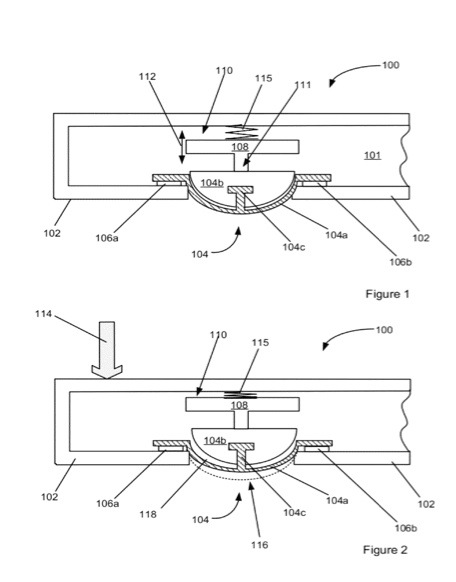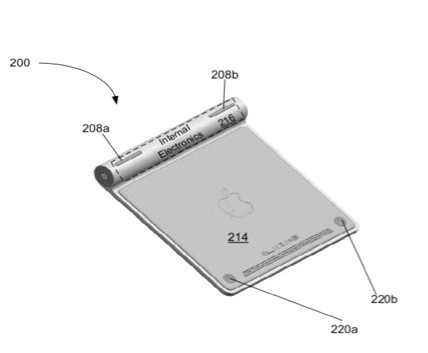An Apple patent (number 8213177) for a device foot has appeared at the U.S. Patent & Trademark Office. A moveable device foot for an electronic device is described, such as that on the Magic Trackpad and Apple keyboard.
The device foot can include a rigid weight bearing member and a flexible sealing member that is integrally formed with the weight bearing member. The device foot can be formed using a double-shot injection molding process. The weight bearing member of the foot can be mounted to an interior portion of the electronic device such that it extends through an external casing of the electronic device.
The flexible sealing member can be mounted to the external casing to seal the interior of the electronic device. During operation of the electronic device, the device foot can be configured to move relative to the external casing, such as in response to an external force applied to the electronic device.
Here's Apple's summary of the invention: "Broadly speaking, the embodiments disclosed herein describe a moveable device foot well suited for use in a consumer electronic device, such as a device including a touch-based interface. In particular, a moveable device foot for an electronic device is described.
"When the electronic device is placed on a surface, the moveable device foot can be used to support a portion of the weight of the electronic device. In addition, in response to a touch-based input, the moveable device foot can be configured to contribute to a range of movement associated with the touch-based interface.
In particular embodiments, the moveable device foot can include a rigid weight bearing member and a flexible sealing member or a cosmetic member that are integrally formed. The weight bearing member of the foot can be mounted to an interior portion of the electronic device such that it extends through an external casing of the electronic device. When a flexible sealing member is used, it can be mounted to the external casing to seal the interior of the electronic device.
"During operation of the electronic device, the device foot can be configured to move relative to the external casing, such as when an external force is applied to the electronic device. The external force can result from a user interaction with the electronic device, such as during a touch-based input process.
"When the electronic device rests on a surface, such as a desk, an internal mechanism, coupled to the device foot, can be configured to hold the device foot in a position where it extends a maximum distance through the external casing. In one embodiment, the internal mechanism can be part of a switch. The internal mechanism can be configured to support a portion of the weight of the electronic device where the portion of the weight that is supported by the internal mechanism is transmitted through the device foot.
"In response to an external force of sufficient magnitude being applied to the electronic device, such as a user pressing down on top of the electronic device to provide a touch input, the device foot can be configured to recede into the external casing, which allows the external casing to move towards the surface. When the external force is removed, the internal mechanism can return the foot to its original extended position and the external casing can move away from the surface.
"In one embodiment, the device foot can be formed using a double-shot injection molding process. In the first shot, the rigid weight bearing member, including an interior hollow portion, can be formed. During the second shot, the flexible sealing member can be formed. To anchor the flexible sealing member of the foot to the rigid weight bearing member, a portion of the flexible sealing member can be extruded into the hollow interior portion of the rigid weight bearing member during the second shot.
"The materials used for the flexible sealing member can be selected so that the flexible member and the rigid member do not bond together during the injection molding process and can easily separate from one another when the two components are pulled apart."
The inventors are Erik A. Uttermann, Rico Zorkendorfer and Andrew Lauder.
Also new at the U.S. Patent & Trademark Office are:
° An Apple patent (number 8213389) for location determination. Among other things, the invention includes a method for obtaining, in a mobile device, power information indicating a detected power of respective signals received from multiple transmitters.
° An Apple patent (number 8213168) for assembly of a display module. A portable computing device is disclosed. The portable computing device can take many forms such as a laptop computer, a tablet computer, and so on.
° An Apple patent (number 8214315) for systems and methods for prioritizing mobile media player files. The invention includes embodiments of systems and methods for prioritizing mobile media player files by providing for the automated addition and/or deletion of media items for a mobile media player.
° An Apple patent (number 8213946) for a method and system for managing delivery of communications such as advertisements to mobile telephone subscribers where delivery to subscribers is temporarily prevented or blocked at the request of the subscribers.
° An Apple patent (number 8214548) for secure configuration of a computing device. A configuration indication is received into the computing device, including receiving a digital signature generated based on the configuration indication.
° An Apple patent (number 8214699) for a method and apparatus for managing power in computer systems. invention is directed towards minimizing power consumption in computer systems. One embodiment of the invention is a power management system that is used for a computer system that has at least one device and one power domain.
° An Apple patent (number 8214740) for song flow methodology in random playback. An electronic device can play back media items using a random playback mode. To ensure that related media items are played back in a proper order (e.g., live music is played back in concert order), the electronic device can define metadata or other data coupling related media items in a predefined or preset sequence.
° An Apple patent (number 8214768) for a method, system and graphical user interface for viewing multiple application windows.
° An Apple patent (number 8214822) for methods and systems for updating a candidate computer program file.














